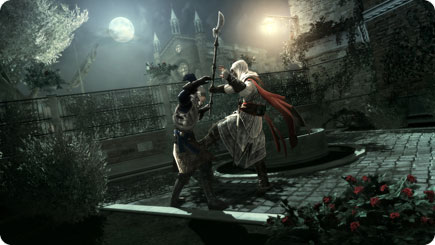
Ezio Auditore da Firenze. Or, should I say, Desmond Miles, who is living out the memories of Ezio, his ancestor, through a modern-day machine called the Animus. After his father and two brothers were executed during a political betrayal, Ezio took to the shadows, learning the assassin’s ways while seeking revenge against Rodrigo Borgia, who led the conspiracy that destroyed Ezio’s family. (While Ezio is fictitious, Borgia is based on a historical figure.)

Live to Fight Another Day. Of course, Ezio is just as skilled at beating a hasty retreat.
Boivin and I hurry down the street, hoping to get another glimpse of wily Ezio. “We always come back to the assassin’s creed: nothing is true, everything is permitted,” Boivin explains. “People should always think for themselves, make their own truths, and not blindly abide by a set of morals, truths, and values set upon them by some form of authority.”
“I always try to opt for what the assassins were from the beginning: a blade in the crowd.”
- Jean-Francois Boivin, development team member
Indeed, the political machinations against Ezio, who is now considered a criminal and a traitor, run much deeper than a Renaissance era power struggle: Borgia also leads the Knights Templar, who exist in the present day as a company named Abstergo, developer of the Animus. Throughout history, the Templars have been seeking artifacts known as Pieces of Eden, which they believe will allow them to enslave the minds of nearly everyone in the world. A shadowy group of assassins have always opposed the Templars, and Desmond finds himself in the middle of that battle in the year 2012, just as Ezio did in the 1490s.

Dance With the Devil in the Pale Moonlight. Ezio moves closer to his goal.
A Blade in the Crowd
Boivin and I round a corner just in time to see Ezio slip from a rooftop and silently drop into a pile of hay in a cart. No one notices. Stealth is key in Assassin’s Creed II; you’re typically better off sneaking up on enemies than attacking them head-on. “Personally, I always try to opt for what the assassins were from the beginning: a blade in the crowd,” Boivin says while we wait for Ezio to emerge. “I try to approach using rooftops for traveling and then getting in the crowd at ground level, blending in and approaching my target without being detected.”

Hiding in Plain Sight. They may not anticipate the most obvious approach.
Thankfully, our presence has no impact on Ezio’s situation, and he’s able to slide out of the hay while we watch. We follow him as he creeps down an alley, seemingly merging with his surroundings — it’s as if we’re watching a moving piece of scenery. Of course, there’s a reason for all the sneaking around, as we see when Ezio enters a courtyard and comes upon a guard with his back turned. After Ezio eliminates his foe, however, two more guards emerge from an alcove, and a conventional battle breaks out.
Game Hardware
Check out our systems for your best gaming experience.
- Site: Assassin’s Creed II
- Publisher: Ubisoft
- Developer: Ubisoft
- Genre: Action
Game Media
“We always come back to the assassin’s creed: nothing is true, everything is permitted.”
- Jean-Francois Boivin, development team member
Boivin observes: “One thing that came up a lot with fans of the game was the first one’s fighting system, which many thought was slow-paced and lacked variety, so we wanted to improve upon that in Assassin’s Creed II. Adding more weaponry, more counter kills, and more moves was how we attacked that need. The AI system was also much improved, which required us to invest in more ways to use social stealth, such as hiding spots and blend groups.”
Ezio dispatches the last of his enemies and takes a break. I ask Boivin about the decision to include a young Leonardo da Vinci, who turns out to be a key ally of our hero by decoding mysterious writings left behind by Altaïr, a 12th century assassin whose memories were visited by Desmond in the first game. Boivin nods and responds: “There were very important historical events that happened in Florence and Venice between 1470 and 1500 that we wanted to include, such as the Pazzi conspiracy and Borgia becoming Pope Alexander VI.

Free-For-All. Sometimes you just need to confront the opposition head-on.
“Then it was just a question of validating how old Leonardo was at that time. I think it turned out great, because everyone sees in their mind’s eye this old self-portrait of Leonardo and don’t really think of how he would have been as a young man.”
An Open Game World
Ezio slips into the shadows once more, headed off on another mission, but we let him go as Boivin motions to the beautiful Renaissance architecture around us. “There’s not that much documentation on 12th century cities like Jerusalem and Damascus, but for Assassin’s Creed II, we had access to detailed maps of Florence and Venice, to name a couple,” he says. “We also hired some very prominent historians who helped us not only with historical accuracy but also while we went location scouting in Italy.”

Aerial Assault. Ezio knows plenty of ways to attack his enemies.
Boivin adds: “We took over 35,000 photos while we were there: architecture, building textures, roads, basically everything. The historians were there to let us know which buildings were from the Renaissance and to give us insight into how people lived back then.”
We start walking again. Boivin concludes: “Our mandate was to revolutionize the action adventure genre and bring about an open game world where the player can free-run anywhere in a huge city.”


